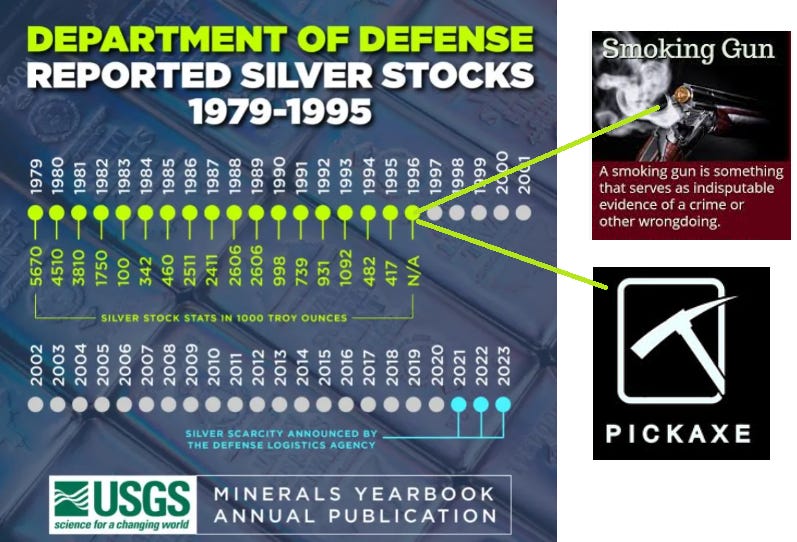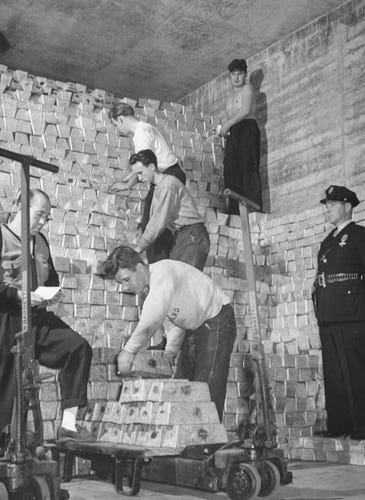Why did the United States stop reporting on Department of Defense usages of Silver?
Functions of the Former US Bureau of Mines were reassigned to other departments of the Federal Government. The statistical gathering of Department of Defense silver failed to be reassigned.
Silver stockpile located in West Point, New York
After World War I, the US War Dept and Weapons industry began raiding the US Strategic Stockpile of Silver.
By the mid-1940s, the draining of the Strategic stockpile was so exhaustive that the US began a campaign of disinformation using the CIA and a moving target of US Government agencies (like a 3 card Monte sleight of hand trick) to alter historical records of the percentages of silver used in various industrial uses in place of military applications.
Weapons manufacturers and other industrialists, many of whom sit on the banking board of directors, begin a plan to use paper future derivative trading to keep silver prices artificially low (in addition to draining strategic stockpiles). Why? Industrialists want low factory inputs (raw materials, labor, overhead, etc), thus yielding more significant profit margins and the ability to make more weapons.
By the present day, because of all this secret military use and silver price suppression schemes (that made silver an inexpensive mineral for hundreds of military applications), The US has begun experiencing record silver deficits and 79% import reliant on silver from foreign nations
Silver on Brink of Extinction as Department of War Heist and Bankers Steal All the Silver.
Jon Forrest Little connects the dots in brief video below (with a slideshow for teacher lesson plans, history, math, science, sociology, political science, foreign policy, etc)
Timeline: Silver Raid by US Government
Investigation Phase
1. Silver Reporting Commences (1979):
The Department of Defense initiates reporting of silver inventories from the US strategic silver stockpile.
2. Reporting Abruptly Ends (1996):
Reporting on silver inventories comes to an abrupt halt.
3. The very Same Year, United States Bureau of Mines Closure (1996):
Coincides precisely with the cessation of silver reporting.
The Bureau of Mines played a significant role in inventory and record-keeping of US silver.
4. A Covert Shift (Post-1996):
Mysterious re-assignment of silver usage reporting from the United States Bureau of Mines to the United States Geological Survey (USGS).
The USGS is known for water, earth, natural resources, minerals including silver, biological science, and civilian mapping.
5. USGS's Reputable Image (Pre-Investigation):
USGS holds a reputation for data collection, monitoring, analysis, and providing insights into natural resource conditions and problems.
Concealing the hidden agenda.
6. Hidden Division: National Minerals Information Center:
Within the USGS, a shadowy division, the National Minerals Information Center, emerges.
This division reports limited silver usage annually
This is what jumps out.
What are they hiding?
More News from The Pickaxe and Silver Academy
7. Initial Revelation (Months Ago):
The initial exposure falls on death ears.
8. Ongoing Data Retrieval (Present):
In-progress efforts to extract crucial evidence
from aged military filing cabinetsusing open source investigating protocol
9. Unveiling the Crime Pattern (Present):
The scheme's motives and opportunities come into focus.
The key players include the Department of Defense, the Department of the Interior, the United States Bureau of Mines, and the USGS.
10. Path to Legal Resolution (Forthcoming):
The accumulation of evidence lays the groundwork for around the clock reporting.
11. Intentional and Distorted USGS Reporting (Throughout Investigation):
USGS reports on primary silver market and industrial uses remain misleading.
We begin seeing the intensification of misleading reports doctoring up bogus percentages of silver used by various industrial categories. Moreover, these reports from USGS fail to present the complete picture. Obfuscating that militaries and aerospace (almost always overlap) are by far the primary industrial users of silver
source - https://pubs.usgs.gov/periodicals/mcs2023/mcs2023-silver.pdf
12. Military's Silver Consumption (Throughout Investigation):
The military's silver usage is calculated to eclipse all reported categories.
The military’s silver usage is more than 10x greater than USGS categories, which goes to great lengths to list every use under the sun except military use (e.g., investment bars, electronics, coins/medals, solar, jewelry and silverware, brazing and solder, and other)
13. Understanding Military Usage (Throughout Investigation):
Exploration of military applications of silver, including rockets, missiles, bombs, shells, fighter jets, satellites, tanks, submarines, torpedoes, night vision goggles, communication devices, radar ….
But today we reveal the largest use of silver in World’s History are nuclear weapons.
Conclusion Phase
14. Delving into the Explosive Use of Silver:
Commencing our report with a detailed examination of the role of silver in weaponry, beginning with research in Los Alamos, leading to the Trinity test site explosion in White Sands, New Mexico.
In this unfolding narrative, we're poised to expose a complex web of deception and secrecy, unveiling what's been concealed for too long.
Timeline: The Manhattan Engineering District (MED) Our research shows it is called THE SILVER PROJECT
Investigation Phase
1. The Enormous Gamble (Early 1940s):
Billions of dollars invested in the secret construction of facilities for a potentially unreliable devastating weapon.
2. Global Conflict and Nazi Threat (1930s-1940s):
World War II and the looming fear of Nazi Germany developing a powerful weapon first add urgency to the project.
3. Untold Subplots (Throughout the 20th Century):
While the main aspects of the Manhattan Project have been well-documented, certain elements remain hidden.
4. Unveiling the Silver Program (Recent Years):
Research unveils lesser-studied facets, including the "Silver Program."
Secret Government Project Management
5. Project Transition (1942):
The project shifts from the Office of Scientific Research and Development to the War Department.
6. Colonel James C. Marshall's Role (1942-1943):
Marshall is tasked with establishing the Manhattan Engineer District (MED).
The secret government project to build the bomb was handed from the Office of Scientific Research and Development to the War Department in 1942. Management fell first to Colonel James C. Marshall of the Syracuse District of the U.S. Army Corps of Engineers. Marshall was ordered to establish a new district with no geographical boundaries. Its first offices were at the Atlantic Division headquarters on Broadway in New York City, hence the origin of the “Manhattan Engineer District” (MED), later called the Manhattan Project.
7. Brigadier General Leslie Groves' Appointment (September 1942):
Groves takes command of the MED.
8. Critical Leadership Shift (August 1943):
Colonel Kenneth Nichols replaces Marshall as District Engineer.
The Quest for Enriched Uranium
9. The Paramount Challenge (Early 1940s):
The MED grapples with producing sufficient enriched uranium for the atomic bomb.
10. Electromagnetic Mass Spectroscopy (1942):
This method shows promise but requires massive quantities of copper.
11. The Silver Solution (1942):
The idea of using silver as a substitute for copper to avoid depletion during the war emerges.
12. Borrowing Treasury Silver (August 1942):
Nichols meets with Undersecretary of the Treasury Daniel Bell to inquire about borrowing silver.
13. Silver Units of Measure (August 1942):
A discussion of the troy ounce measurement and fine troy ounces.
14. Need for Silver at Y-12 (1942-1943):
Silver's essential role in electromagnetic mass spectroscopy.
15. Mass Spectroscopy in Operation (1942-1945):
The working of mass spectroscopes and the necessity for silver.
Official Requests and Silver Withdrawal
16. Secretary of War's Request (August 1942):
Secretary of War Henry Stimson formally requests the silver from Secretary of the Treasury Henry Morgenthau Jr. (but had written
17. Detailed Request Terms (August 1942):
Stimson's letter outlines terms of the silver request, including fineness and return conditions.
18. Silver Withdrawal Begins (October 30, 1942):
The first bars are taken from the West Point Bullion Depository, equivalent to 7,500 midsize automobiles.
400,000 silver bars
each bar 1000 ounces
Totals 4,000,000 (4 Million ounces)
19. Casting and Cleanup (October 1942 - January 1944):
The bars are cast into billets and meticulous cleanup operations ensure minimal loss.
20. Shaping and Extrusion (Early 1940s):
Billets are extruded into strips and further processed into coils.
21. Creation of Coil Strips (Early 1940s):
The creation of coil strips in New Jersey using Treasury silver.
22. Transport to Wisconsin (Early 1940s):
Strips are shipped to Wisconsin for magnet coil fabrication under heavy guard.
23. Formation of Busbars (Early 1940s):
On-site production of busbar pieces in Oak Ridge, including drilling and fastening.
24. Magnet Winding and Shipping (1943-1944):
Winding and assembly of magnets in Milwaukee, each containing around 14 tons of silver.
940 magnets were wound.
On average, each contained about 14 tons of silver.
Pixy Livingston on the case
25. Delivery to Oak Ridge (1943-1944):
Finished magnet coils are transported to Oak Ridge for the final assembly.
This comprehensive outline reveals the covert use of Treasury Department silver in the Manhattan Project, a hidden chapter in the development of the atomic bomb.
940 magnets were wound. On average, each contained about 14 tons of silver.
All this extraordinary silver use documented above does not capture tomorrow's report, which gets into how many nuclear bombs have been made since the Trinity Blast.
All the calculations in today's report only capture silver use leading up to the Trinity Test. It's gone hyper-parabolic since that event. We will start tomorrow's report with a chart by University Professor Simon Michaux showing how rare silver is on Planet Earth. Silver is on The Brink of Extinction.
To be continued tomorrow.
We reveal more cover-ups, including documents from the CIA, then start putting the total nuclear bombs, tests, and existing inventory into a spreadsheet that makes these numbers look like one piece of sand on a beach (in comparison)














